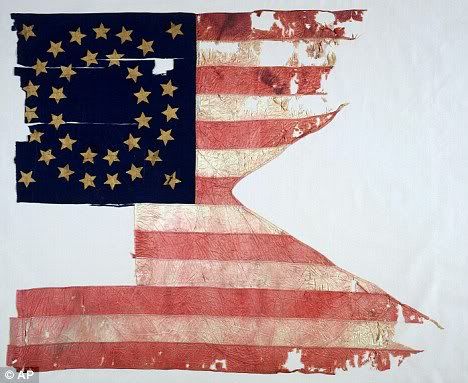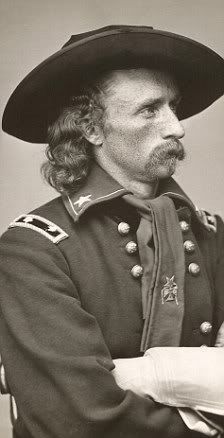
The American flag was retrieved from under the body of a fallen soldier, following the Battle of the Little Bighorn in 1876
An American flag found at the site of the carnage of the Battle of the Little Bighorn is expected to fetch over £3million at auction.
The flag was retrieved from the Black Hills of Montana, where Lt Col George Custer and more than 200 men were massacred by Indian warriors in 1876.


Lt Col George Custer (left) and more than 200 men were massacred by Indian warriors led by Sitting Bull (right)
Nearly all the military artefacts of the 7th Cavalry Regiment were carried away by the victorious Lakota Sioux, but the single swallowtail flag was found days later under the body of a fallen soldier.
Since 1895, the silk American flag, called a guidon, has been the property of the Detroit Institute of Arts, which has decided to sell it and use the proceeds to build its collection.
The guidon, discovered by Sgt. Ferdinand Culbertson while on a burial detail of the battlefield, has been valued at $2 million to $5 million and is to be auctioned in October, Sotheby's auction house announced on Friday, the 134th anniversary of the battle.
The current auction record for any textile is $12.3 million, for an American flag captured by the British in a 1779 battle in Bedford, New York. Sotheby's was sold it in 2006.
The Battle of the Little Bighorn, also known as Custer's Last Stand, resulted in the deaths of 210 soldiers, including Custer, as several thousand warriors led by Sitting Bull fought for their land near what's now Crow Agency, Montana.
The Black Hills in southeastern Montana (present-day South Dakota) were declared Indian land in the late 1860s. The conflict erupted when the government tried to drive the Indians off the land after white settlers discovered gold there.
The 1876 battle's devastating loss came as a great shock to the nation as it prepared to celebrate its centennial.
The battle was a pivotal moment in American history, told and retold in books, in film, on stage, and in song as mystical portrayals of Custer's bravery. Custer was a native of eastern Ohio, but moved with his family to Monroe at age 10 and considered that his home.
Although the view of Custer as a hero has changed over time, anything associated with the battle still resonates, Sotheby's said.'It's still one of those truly legendary events of 19th-century American history, and I suppose for a reason it was this extraordinary clash between the two cultures of America,' David Redden, Sotheby's vice chairman, said.
'However you look at it, it's still an extraordinary and tragic encounter. Anything connected with that, particularly something that's as significant as a battle flag, also has that kind of iconic stature.'
The guidon measures 32 1/2 inches by 26 1/2 inches. One star and a patch of the white and red stripes are missing, cut from it as souvenirs, a common 19th-century practice, Sotheby's said.
'It means the flag was considered a sacred relic,' Redden said.
'Literally, it was absolutely par for the course to take small snippets of extraordinary objects, whether it's the dress of Martha Washington, which was snipped to pieces, or the Star-Spangled Banner.'
The 7th Cavalry had five guidons and one regiment flag. Three of the guidons have vanished, and the fourth, known as the Keogh guidon, is in very poor condition, eaten by moths, Redden said.
The regiment flag was on a train en route to the battlefield when the 7th Cavalry was annihilated. That flag and the Keogh guidon are owned by the Little Bighorn Battlefield National Monument in Crow Agency.
Company guidons at Little Bighorn were abbreviated versions of the American flag, said John Doerner, the monument's historian.
Each had a V-shaped cutout at the end to reduce wind drag, and they 'served as beacons on the battlefield because they actually marked company positions,' he said.
He called the guidon Culbertson found a 'national treasure.'
'It's part of American history and heritage that's being sold,' he said.
'It would be nice to have that guidon returned to the Little Bighorn Battlefield Monument. It could be enjoyed by the public coming to this very hallow ground.'
Graham W.J. Beal, director of the Detroit Institute of Arts, said that because the guidon doesn't fit the criteria for a work of art, the museum hopes 'to exploit it for our real mission, which is to collect and interpret art.'





0 comments:
Post a Comment